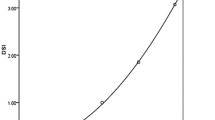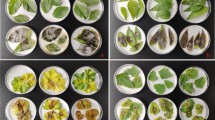Abstract
Metalaxyl is the most widely used fungicide to control Phytophthora diseases. A detached leaf bioassay was developed to quantify metalaxyl efficacy using metalaxyl-sensitive (CbP01) and metalaxyl-resistant (CbP03) isolates of Phytophthora palmivora as biological indicators. The linearity of pathogen growth on metalaxyl-treated leaves ranged from 1.6–200 ppm. This assay was applied to determine metalaxyl efficacy on durian leaf after foliar spraying and soil drenching at concentrations of 2 and 4 g/l. Metalaxyl applied as foliar spray inhibited the growth of CbP01 up to 80% for 30 days after application and up to 62–65% inhibition 60 days after application. Soil drenching strongly inhibited the growth of both CbP01 and CbP03 isolates with inhibition greater than 90% for at least 60 days after application. Although soil drenching was more effective than foliar spraying in controlling P. palmivora, soil drenching with 4 g/l metalaxyl resulted in seedling death within 15 days after application. This simple bioassay to evaluate the efficacy and persistence of metalaxyl in planta is beneficial for designing and optimizing metalaxyl application with maximum efficiency and minimum negative impacts on human health and the environment.





Similar content being viewed by others
Data availability
The datasets generated during and/or analyzed during the current study are available from the corresponding author on reasonable request.
References
Bailey AM, Coffey MD (1984) A sensitive bioassay for quantification of metalaxyl in soils. Phytopathology 74:667–669
Bruin GCA, Edgington LV, Ripley BD (1982) Bioactivity of the fungicide metalaxyl in potato tubers after foliar sprays. Canadian Journal of Plant Pathology 4:353–356
Drenth A, Guest DI (2004) Principles of Phytophthora disease management. In: Drenth A, Guest DI (eds.) Diversity and management of Phytophthora in Southeast Asia. Australian Centre for International Agricultural Research Monograph, BPA Print Group Pty Ltd, Melbourne, Australia. 114:154–160
Environmental Protection Agency (1994) R.E.D. FACTS Metalaxyl. Available at https://www3.epa.gov/pesticides/chem_search/reg_actions/reregistration/fs_PC-113501_1-Sep-94.pdf. Accessed on August 1, 2018
Erwin DC, Ribeiro OK (1996) Phytophthora diseases worldwide. APS Press, St Paul, Minnesota, USA
Gikas GD, Parlakidis P, Mavropoulos T, Vryzas Z (2022) Particularities of fungicides and factors affecting their fate and removal efficacy: a review. Sustainability 14:4056.
Kabir MdH, El-Aty AMA, Rahman MdM, Chung HS, Lee HS, Jeong JH, Wang J, Shin S, Shin HC, Shim JH (2018) Dissipation kinetics, pre–harvest residue limits and dietary risk assessment of the systemic fungicide metalaxyl in Swiss chard grown under greenhouse conditions. Regulatory Toxicology and Pharmacology 92:201–206
Lalancette N, Gager J, McFarland KA (2015) An in vivo bioassay for estimation fungicide residues on peach fruit. Plant Disease 99:1727–1731
Liu C, Wan K, Huang J, Wang Y, Wang F (2012) Behavior of mixed formulation of metalaxyl and dimethomorph in grape and soil under field conditions. Ecotoxicology and Environmental Safety 84:112–116
Liu X, Yang Y, Cui Y, Zhu H, Li X, Li Z, Zhang K, Hu D (2014) Dissipation and residue of metalaxyl and cymoxanil in pepper and soil. Environmental Monitoring and Assessment 186:5307–5313
Malhat FM (2017) Persistence of metalaxyl residue on tomato fruit using high-performance liquid chromatography and QuEChERS methodology. Arabian Journal of Chemistry 10:765–768
Matheron ME, Matejka JC (1988) Persistence of systemic activity for fungicides applied to citrus trunks to control Phytophthora gummosis. Plant Disease 72:170–174
Matheron ME, Mircetich SM (1985) Control of Phytophthora root and crown rot and trunk canker in walnut with metalaxyl and fosetyl Al. Plant Disease 69:1042–1043
Milgroom MG, Fry WE (1987) A metalaxyl bioassay for large numbers of small painting samples. Phytopathology 77:237–240
Morton V, Staub T (2008) A Short History of Fungicides. Available at https://www.apsnet.org/edcenter/apsnetfeatures/Pages/Fungicides.aspx. Accessed on August 15, 2018
Pappas AC (1985) Metalaxyl resistance in Phytophthora infestans on greenhouse tomatoes in Greece. Plant Pathology 34:293–296
Phetkhajone S, Pichakum A, Songnuan W (2021) The study of the kinetics of metalaxyl accumulation and dissipation in durian (Durio zibethinus L.) leaf using High-Performance Liquid Chromatography (HPLC) technique. Plants 10(4):708
Ramezani MK, Shahriari D (2015) Dissipation behavior, processing factors and risk assessment for metalaxyl in greenhouse-grown cucumber. Pest Management Science 71:579–583
Stone JR, Verma PR, Dueck J, Westcott ND (1987) Bioactivity of the fungicide metalaxyl in rape plants after seed treatment and soil drench applications. Canadian Journal of Plant Pathology 9:260–264
Stefanello MT, Balardin RS, Minuzzi SG, Favera DD, Marques LN, Pezzini DT, Ebone A (2016) Effect of the interaction between fungicide application time and rainfall simulation interval on Asian soybean rust control effectiveness. Semina: Ciências Agrárias 37:3881–3892
Thomidis T (2002) Persistence of the systemic activity of metalaxyl and fosetyl-Al applied as a soil drench or foliar spray to control Phytophthora crown rot of peach. Phytopathologia Mediterranea 41:28–32
Thomidis T, Tsipouridis K (2001) Effectiveness of metalaxyl, fosetyl-Al, dimethomorph, and cymoxanil against Phytophthora cactorum and P. citrophthora of peach tree. Phytopathologia Mediterranea 40:253–259
Wang F, Zhu L, Wang X, Wang J, Wang J (2015) Impact of repeated applications of metalaxyl on its dissipation and microbial community in soil. Water, Air, and Soil Pollution 226:430
Wang F, Zhou Y, Zhu L, Wang X, Wang J, Wang J, Du Z, Li B (2019) Effects of successive metalaxyl application on soil microorganisms and the residue dynamics. Ecological Indicators 103:194–201
Wu S, Yu W, Sun C, Zheng K, Zhang H, Huang M, Hu D, Zhang K (2017) Simultaneous determination of residues of metalaxyl, cyazofamid and a cyazofamid metabolite in tobacco leaves and soil by liquid chromatography with tandem mass spectrometry. Biomedical Chromatography 32:1–6
Yang Y, Liu X, Zhu H, Li Z, Cui Y, Zhang K, Hu D (2015) Determination of metalaxyl in potatoes and soil by dispersive solid–phase extraction and high–performance liquid chromatography. Instrumentation Science & Technology 43:53–64
Acknowledgements
The authors are grateful, thank Dr. Thomas Neal Stewart for his suggestions on preparing the manuscript and proofreading, Department of Plant Science, Faculty of Science, Mahidol University for equipment support and technical help, all durian plantation owners for providing research materials, and The Science Achievement Scholarship of Thailand (SAST) for financial support. This research is supported by the Center of Excellence on Agricultural Biotechnology, Science and Technology Postgraduate Education and Research Development Office, Office of Higher Education Commission, Ministry of Higher Education, Science, Research and Innovation (AG-BIO/PERDO-CHE), Bangkok, Thailand.
Author information
Authors and Affiliations
Contributions
Supawadee Phetkhajone: Conducted experimental research, Data collection and analysis, Writing – original draft, compose figures, revised, and edited. Umaporn Siriwattanakul: Writing – review and editing. Nussara Putaporntip: Writing – review and editing. Aussanee Pichakum: Conceptualization, Supervision analyses – advice on experimental design. Wisuwat Songnuan: Conceptualization, Methodology, Project administration, reviewed and edited manuscript as corresponding author. All authors have read and agreed to the published version of the manuscript.
Corresponding author
Ethics declarations
Conflict of interest
The authors declare that they have no known competing financial interests or personal relationships that could have appeared to influence the work reported in this paper.
Additional information
Publisher's Note
Springer Nature remains neutral with regard to jurisdictional claims in published maps and institutional affiliations.
Rights and permissions
Springer Nature or its licensor (e.g. a society or other partner) holds exclusive rights to this article under a publishing agreement with the author(s) or other rightsholder(s); author self-archiving of the accepted manuscript version of this article is solely governed by the terms of such publishing agreement and applicable law.
About this article
Cite this article
Phetkhajone, S., Siriwattanakul, U., Putaporntip, N. et al. Bioassay for validation of metalaxyl persistence to control Phytophthora palmivora infection in durian. Trop. plant pathol. 49, 209–217 (2024). https://doi.org/10.1007/s40858-023-00621-5
Received:
Accepted:
Published:
Issue Date:
DOI: https://doi.org/10.1007/s40858-023-00621-5




